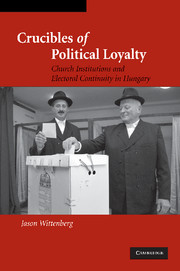Book contents
- Frontmatter
- Contents
- List of Figures
- List of Tables
- Acknowledgments
- INTRODUCTION
- 1 EXPLAINING POLITICAL PERSISTENCE
- 2 ELECTORAL PERSISTENCE AND VOLATILITY IN HUNGARY
- 3 THE CHURCHES FIRST CONFRONT COMMUNISM
- 4 THE BATTLE FOR SOULS, 1948–1956
- 5 THE BATTLE FOR SOULS AFTER 1956
- 6 CHURCH COMMUNITY AND RIGHTIST PERSISTENCE: STATISTICAL EVIDENCE
- 7 CONCLUSION
- Appendices
- Bibliography
- Index
- Titles in the series
6 - CHURCH COMMUNITY AND RIGHTIST PERSISTENCE: STATISTICAL EVIDENCE
Published online by Cambridge University Press: 02 September 2009
- Frontmatter
- Contents
- List of Figures
- List of Tables
- Acknowledgments
- INTRODUCTION
- 1 EXPLAINING POLITICAL PERSISTENCE
- 2 ELECTORAL PERSISTENCE AND VOLATILITY IN HUNGARY
- 3 THE CHURCHES FIRST CONFRONT COMMUNISM
- 4 THE BATTLE FOR SOULS, 1948–1956
- 5 THE BATTLE FOR SOULS AFTER 1956
- 6 CHURCH COMMUNITY AND RIGHTIST PERSISTENCE: STATISTICAL EVIDENCE
- 7 CONCLUSION
- Appendices
- Bibliography
- Index
- Titles in the series
Summary
Introduction
Chapter 2 illustrated extraordinary electoral continuities and discontinuities between pre- and postcommunism. Chapters 3 through 5 retold the Churches' battle against the Party's efforts to remake partisan attachments in society, documenting the often brave struggle of the local clergy and the laity to preserve church community through decades of repression and informal incentives to abandon the Churches. We saw that Roman Catholic priests tended to more actively mobilize their parishioners against the communists than Calvinist pastors, and that church community tended to be higher among Catholics than among Calvinists. This chapter brings together the quantitative findings of Chapter 2 with the historical arguments of Chapters 3 through 5. It demonstrates through a series of statistical analyses that church community transmitted precommunist rightist attachments into postcommunist politics.
There are numerous pitfalls on the path toward generating statistical estimates of the effect of church community, each of which must be recognized and, if possible, addressed. First, as in prior chapters, I employ the fraction of children registered for religious instruction in the schools as a proxy for church community in each settlement. Although these data are the richest available that can also be matched with pre- and postcommunist electoral outcomes, it bears repeating that they are an imperfect measure and almost certainly underestimate the actual level of church community. For example, the elderly are ignored entirely. They are more likely to attend church, but have no children to boost religious instruction.
- Type
- Chapter
- Information
- Crucibles of Political LoyaltyChurch Institutions and Electoral Continuity in Hungary, pp. 201 - 236Publisher: Cambridge University PressPrint publication year: 2006



